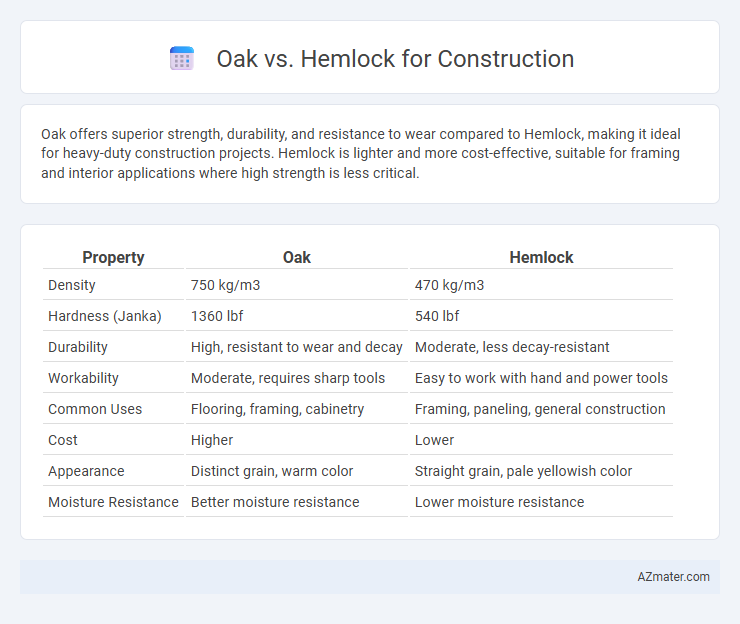Oak offers superior strength, durability, and resistance to wear compared to Hemlock, making it ideal for heavy-duty construction projects. Hemlock is lighter and more cost-effective, suitable for framing and interior applications where high strength is less critical.
Table of Comparison
| Property | Oak | Hemlock |
|---|---|---|
| Density | 750 kg/m3 | 470 kg/m3 |
| Hardness (Janka) | 1360 lbf | 540 lbf |
| Durability | High, resistant to wear and decay | Moderate, less decay-resistant |
| Workability | Moderate, requires sharp tools | Easy to work with hand and power tools |
| Common Uses | Flooring, framing, cabinetry | Framing, paneling, general construction |
| Cost | Higher | Lower |
| Appearance | Distinct grain, warm color | Straight grain, pale yellowish color |
| Moisture Resistance | Better moisture resistance | Lower moisture resistance |
Introduction to Oak and Hemlock in Construction
Oak stands out in construction for its exceptional strength, durability, and resistance to wear, making it ideal for structural beams, flooring, and cabinetry. Hemlock, valued for its lightweight and workable properties, is commonly used in framing, sheathing, and general carpentry where moderate strength is sufficient. Both woods offer unique benefits, with oak providing longevity and hemlock delivering cost-effective versatility in building projects.
Wood Strength and Durability Comparison
Oak is renowned for its exceptional wood strength, offering high density and hardness that makes it ideal for heavy structural applications and load-bearing construction. Hemlock, while moderately strong and lighter than oak, provides good durability with natural resistance to decay, though it is more susceptible to insect damage compared to oak. Oak's superior strength-to-weight ratio and resistance to wear and moisture make it a preferred choice for long-lasting architectural elements and flooring, whereas hemlock is often used for framing and general construction where moderate strength suffices.
Resistance to Pests and Decay
Oak offers superior resistance to pests and decay due to its dense grain and high tannin content, making it a preferred choice for exterior construction and structural applications. Hemlock, while easier to work with and more affordable, is more susceptible to insect damage and fungal decay without proper treatment. For projects requiring long-term durability against environmental challenges, oak provides enhanced longevity and minimal maintenance compared to hemlock.
Workability and Ease of Installation
Oak offers excellent workability with its dense grain, allowing for precise cuts and smooth finishes, though it requires sharp tools and more effort due to its hardness. Hemlock is lighter and softer, making it easier to saw, nail, and fasten, which speeds up installation and reduces labor costs. For construction projects prioritizing ease of installation and faster handling, Hemlock is often preferred, while Oak provides superior durability and finish quality at the expense of longer work times.
Cost Analysis: Oak vs Hemlock
Oak generally incurs higher initial costs compared to Hemlock due to its density and durability, making it a premium choice for construction projects requiring long-term strength. Hemlock offers a more budget-friendly alternative with moderate durability, often preferred for framing and less load-intensive applications. Cost efficiency between Oak and Hemlock depends on project scope, where Hemlock reduces upfront expenses but Oak may lower long-term maintenance and replacement costs.
Aesthetic Qualities and Grain Patterns
Oak showcases a prominent, open grain pattern with a coarse texture that highlights its natural beauty in construction projects, offering warm hues ranging from light to medium brown. Hemlock features a tighter, straighter grain with a fine, uniform texture and a lighter, more consistent pale yellow to reddish-brown color palette, ideal for clean and modern aesthetics. The contrasting grain patterns and color tones between oak and hemlock allow builders and designers to choose wood based on desired decorative appeal and structural visibility.
Environmental Impact and Sustainability
Oak and hemlock differ significantly in environmental impact and sustainability for construction; oak, being a slower-growing hardwood, typically requires longer cultivation periods but offers superior durability and longevity, reducing replacement frequency. Hemlock, a softwood, grows faster and is often sourced from sustainably managed forests, making it a more renewable option with a smaller carbon footprint during growth and harvest. Choosing between oak and hemlock depends on balancing oak's durability and hemlock's renewability, both contributing to sustainable construction practices when sourced responsibly.
Typical Applications in Building Projects
Oak is favored for structural components such as beams, flooring, and cabinetry due to its exceptional hardness, durability, and resistance to wear. Hemlock is commonly used in framing, paneling, and general construction where moderate strength and a smooth finish are required at a lower cost. Oak's greater density and natural resistance to decay make it suitable for high-load and exposed applications, while hemlock's lightweight and workability are ideal for interior finishing and non-load-bearing structures.
Maintenance Requirements Over Time
Oak offers superior durability and resistance to wear, requiring minimal maintenance such as periodic sealing to maintain its strength and appearance. Hemlock, being softer and more porous, demands more frequent treatments including sealing and protective coatings to prevent moisture damage and decay. Over time, oak's dense grain structure results in lower upkeep costs compared to hemlock's higher vulnerability to environmental factors.
Choosing the Right Wood: Oak or Hemlock?
Oak offers superior durability and resistance to wear, making it ideal for high-traffic areas and heavy structural applications in construction. Hemlock provides a lighter, more affordable option with good strength and ease of workability, suitable for framing and general carpentry. Selecting between oak and hemlock depends on project requirements such as load-bearing capacity, aesthetic preferences, and budget constraints.

Infographic: Oak vs Hemlock for Construction
 azmater.com
azmater.com